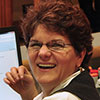This article is more than 5 years old.
I spent Thursday and Friday at the Access Services Conference: Unlocking the 21st Century Library in Atlanta. While this is the first time I attended the conference, it was the third time the conference was held. I found it an interesting conference filled with 500 (not surprisingly) like minded individuals.
The keynote was delivered on Thursday morning by Julie Zimmerman who is Dean of Libraries at Florida State University. (Her bio says she also used to be here, at WFU, so perhaps some of you know her.) She set the tone for the conference talking about the challenges for Libraries and the changes we’ve witnessed from being the “big box” of information right in the center of campus, where people were lucky if they found stuff, to the struggle we face to be relevant as we compete with the internet as the primary source for today’s information. She said that in order to remain relevant, libraries need to align priorities with institutional goals (check!), test assumptions and talk to our users (check!), commit to service that goes beyond the traditional (check!). Her talk was interesting but mostly because I felt like she was telling me we were on the right track. She also discussed the need to refocus our services to meet user needs, (using the example of checking out equipment, which we also do) and liberalize loan policies, utilize delivery services and encourage patron driven acquisition. So, as I said, we are really doing all right here.
I attended several sessions that had similar themes including:
- Cross training staff to be flexible and respond to needs.
- Simplify the user experience
- Combining service desks and the challenges and successes that come from that action
- Aligning staff skills, job descriptions and performance reviews
- Doing more with less (More service, less budget)
Marvin Tillman, from Duke’s Library Service Center, (their Offsite Storage) and I co-presented on a session on called “Shall we go offsite?” We discussed the reasons why libraries should consider this action including:
- better use of library space
- better service
- better security of the collection
- better preservation
- cost less per volume to store in off site vs. storing in the library
We had our session at 2:30 in the afternoon, and it was well received. About half of the attendees had already implemented an offsite storage facility, and maybe another third was considering it. It was a lively discussion, and we didn’t get through all of our slides, but both Marvin and I were approached by about a dozen people asking questions afterward, and saw several people the rest of the evening and next day who had more questions! We seemed to find a touchstone.
On Friday morning I attended a session caled “Google Model Innovation” and was led by the Director of Access Services at Yale Law Library who talked about an experiment he had with using a Google Model to allow the staff to bring him any wild idea that they wanted to implement. Then, if he liked it, and it aligned with their job, he’d give them one day (20%) of their time to implement it. It has now devolved to 10% of their time, but they still have a half day a week to devote to innovations that they really want to see implemented. Two noteworthy things that they’ve implemented as a result of this is 1. Increased digitization of collections and 2. a green team who devote their time to implementing “green” ideas.
One especially interesting session discussed how the library at University of California at Santa Cruz managed to continue to provide service after library hours and staff were cut after a significant (1.9 million dollar) budget cut in 2009. The students reacted with sit ins, “study ins” and protests. Negotiating with the students, creating policies, instituting procedures to protect staff, collections and buildings, all resulted from a very connected leadership who were trying to manage through the difficult time.
I’m happy that I attended the conference. I had a chance to catch up with some colleagues from Michigan, and met with many new people from all across the nation. About 60% of the attendees were from outside of the south, so this really is gaining traction as a national conference.

5 Comments on ‘Mary Beth at Access Services Conference’
I’ll bet you and Marvin were great! Glad it was worthwhile after an emotional week. Bet you are glad to be home.
It is good to be home.
Hope you enjoyed the Road Trip. This conference sounds like it’s really catching on. I’ll be watching for it next year.
It’s interesting that the speakers gave Google the credit for the 20% pet project idea. I first learned about this concept in my library management class (read: before Google existed — yes, I’m old), where the idea was credited to 3M. The Post-It note is allegedly one outcome of this 20% time.
I’m sure there are no better co-presenters than Mary Beth and Marvin. Congrats to you both.